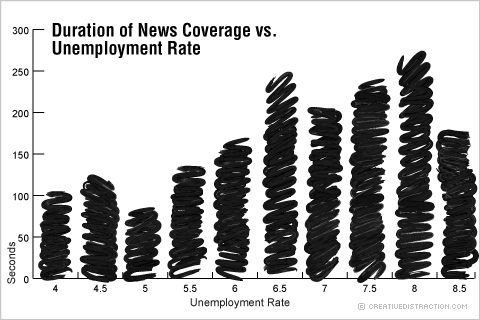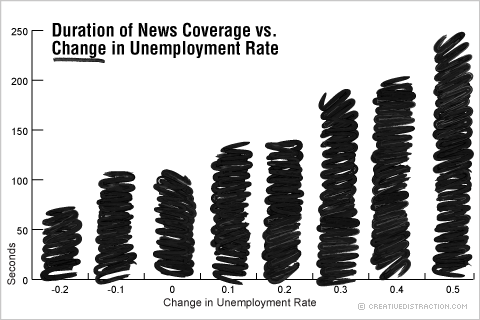With the announcement of today’s “jobs numbers” I thought I should publish some data I collected on how the mass media covers this ritual monthly release of the Bureau of Labor Statistics’ “Employment Situation” report, one of the most regular and widely consumed sources of information about U.S. jobs.
A couple potentially interesting findings are:
- Coverage of the employment situation increases when the situation is bad (i.e. when unemployment is high)
- Job elimination is more newsworthy than job growth
“In this age of massive change in our economy and how people work, we need news sources that analyze the subtler and perhaps ultimately more disruptive changes in the employment situation, changes that won’t necessarily be foreshadowed in the unemployment rate.”
I collected evening news segments from the major television networks — CBS, NBC and ABC — aired on the report release dates between September 2001 and July 2009. The sample period included 102 dates and 254 evening news segments over a significant boom-bust cycle in the American economy and job market, making for a rich and well-rounded data set. Following is what I found, plus some hard-to-restrain thoughts about why what I found might matter.
Coverage of the employment situation increases when the situation is bad. This finding isn’t terribly surprising or illuminating — of course we give employment/unemployment more attention when it is problematic! Still, it’s nice to confirm common sense with data. When you measure, for example, the average duration of TV news segments about the employment situation, you find that the coverage is actually longer in times of strife.

This finding is not unimportant. Consider that, in this age of massive change in our economy and how people work, we need news sources that analyze the subtler and perhaps ultimately more disruptive changes in the employment situation, changes that won’t necessarily be foreshadowed in the unemployment rate. If television networks hinge their coverage so closely to one data point, maybe the evening news is not be the place to find coverage that prepares us for and helps us shape the real future of work?
Job elimination is more newsworthy than job growth. Take a look at the graph below, again showing the average duration of TV news segments about the employment situation, but this time plotted against the relative change in the unemployment rate on the date of airing.

What’s surprising here is not the fact that a 0.5% jump in unemployment leads to more news coverage of the employment situation than a flat month. What’s surprising is that a flat month, where there’s no change in the unemployment rate, leads to more coverage of the employment situation than a month in which the rate drops (in most cases because jobs were added). Job creation, apparently, is not so newsworthy.
The evening news’ emphasis on job elimination over job creation could have any number of causes, from the reporters and editors not knowing how to report such economic good news to the simple media logic that “fear sells better than hope.” Either way, this finding casts still more doubt on network television news as a source for critical information about the employment situation and the future of work.
